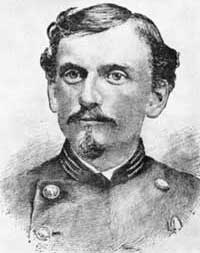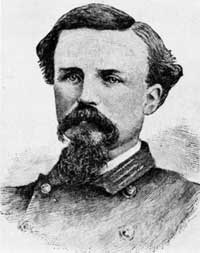|
FORT SUMTER National Monument |
 |
 Capt. John C. Mitchel. From Johnson, The Defense of Charleston Harbor. |
 Capt. Thomas A. Huguenin. From Johnson, The Defense of Charleston Harbor. |
The Third Great
Bombardment
The onset of summer, 1864, brought one more attempt to take Fort Sumter; likewise another officer of the original Fort Sumter garrison came into the operation. Maj. Gen. J. G. Foster, engineer of the fort in April 1861, succeeding to Gillmore's command on May 26, was convinced that "with proper arrangements" the fort could easily be taken "at any time." The "proper arrangements" included special light-draft steamers and 1,000-man "assaulting arks" equipped with elevated towers for sharpshooters and 51-foot scaling ladders. Though initial War Department reaction was cool, Foster went ahead with a preliminary operation to complete the demolition of the fort. "Yankee ingenuity" might succeed where routine operations had failed or been judged too costly.
On July 7, 1864, Foster's batteries opened a sustained bombardment against the ruin of Fort Sumter. During the remainder of that month, an average of 350 rounds daily was hurled at the beleagured fort. In some respects, this was the heaviest bombardment Fort Sumter had yet received. Although the gorge ruin was wasted away at one point to within 20 feet of the water, and the shattered "sea front" was still further reduced, the right face remained erect, its three-gun battery intact, likewise most of the left flank. To Admiral Dahlgren, as late as July 21, the work seemed "nearly impregnable." Debris added to debris, feverish work day and night, and thousands of bags of sand brought from the city by night actually made the fort stronger than ever. If a casemate were breached, it was speedily filled; if the slopes of the ruin invited assault, a bristling array of wooden pikes and barbed-wire entanglements were provided; and there were always the muskets of the 300-man garrison.
The fire slackened in August; Foster's supply of ammunition was dwindling. A scheme for "shaking down" the fort walls by floating down large "powder rafts" failed miserably. Mid-August brought final War Department refusal to supply light-draft steamers; the end of August, sharp disapproval for Foster's "assaulting arks." Meanwhile, Admiral Dahlgren had been unwilling to cooperate in an alternate plan of assault.
With his requisitions for more ammunition unfilled, General Foster was now called upon to ship north most of his remaining ammunition and four more regiments of troops to be used in Grant's operations against Richmond. Foster was ordered to remain strictly on the defensive.
On September 4, the bombardment begun on July 7 came to an end. In the 61 days, another 14,666 rounds had been hurled against the fort. Sixteen of the garrison had been killed, 65 wounded. On July 20, Captain Mitchel fell mortally wounded. Capt. Thomas A. Huguenin succeeded him that night.

|
|
Last Modified: Mon, Dec 2 2002 10:00:00 am PDT |


